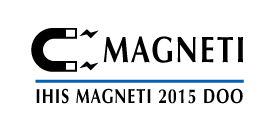About magnets in general
Magnetic hard materials can be divided into metal, ceramic and oxide. Barium ferrite is a representative of ceramic magnets. Ceramic magnets in relation to metal have lower remenential induction, and higher coercive force.
These properties require the construction of ceramic magnets of larger surface, and less length. Large coercive force allows multi-polar magnetism, which is a great advantage of ceramic magnets in relation to metal. In addition to the technical advantages, there are also economic advantages in the use of ceramic magnets, because the raw bases are made of cheap, Good temperature stability + 400 ° C, unlike metal magnets made from very expensive raw materials.
Ceramic magnets are produced with the classic ceramic manufacturing technology. By pressing, a particular magnet form is obtained which is then sintered at a temperature of about 1250 ° C. In the sintering of the dimension they are reduced by about 15%. The barium ferrite has a hexagonal crystal structure with better magnetic characteristics along the crystalline c axis. If a magnetic field is operating during pressing, the particles will be oriented, so the resulting magnet will have better magnetic properties in the direction of the field. This type of magnet is called anisotropic.
Isotropic magnets are sprayed without a magnetic field and their magnetic properties are the same in all directions.
A special type of ceramic magnet is plasticized. Their properties are somewhat weaker, but they have the characteristics of plastic, they are elastic.
Ferrites are iron oxide compounds and divalent metal alloys (ZnO, MnO, NiO, BaO, etc.) that have ferromagnetic properties. Compared to metal ferromagnets, ferrite ceramic magnetic materials have the following advantages: high electrical resistance, which allows the application of ferrite cores high frequencies, high values of initial permeability, ferrite acquisition technologies make it possible to produce cores of various types suitable for use. All these properties make ferrite an irreplaceable magnetic material for electronic components. By applying ferrites are divided into: soft ferrites for the wide consumption of soft ferrites for the professional use of ferrites for memory and switching core of microwave ferrite
